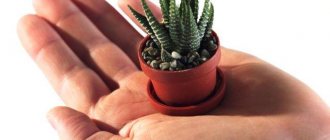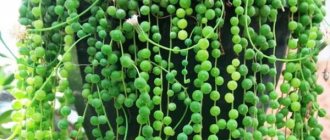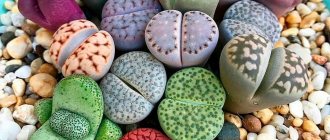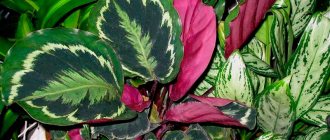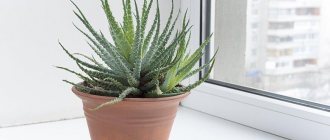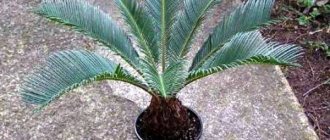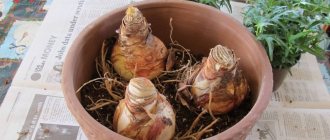Cypress family. Homeland Mediterranean, America.
The commercially available large-fruited cypress Cupressus macrocarpa is small in size and bred specifically as an indoor crop. Cypress is a coniferous crop; it is an evergreen tree with a pyramidal crown. The leaves are small, needle-shaped or scaly, sessile, tightly adjacent to the stems. Cypress tissue contains a large amount of essential oils, so the plant is very useful for the home.
The methods of growing it and caring for it are the same as for araucaria. In stores, especially on New Year's Eve, you can find cypress trees of a wide variety of shapes - trimmed in the form of a pyramid, a bush, a small tree. Cypress really resembles a miniature living Christmas tree and can be a wonderful New Year's gift. True, there are cypress trees that are treated in the store with special sparkles to make them look more like a Christmas tree. In fact, this harms the plant, so it is better to purchase cypress in its natural form, without decoration with glitter and toys.
If you want to decorate a cypress tree for a New Year tree, you can hang colorful rain or paper toys on it, which are practically weightless and will not harm the plant. In general, cypress is an unpretentious plant; the difficulty is that it does not tolerate dry air.
Cypress in a pot - how to care for it at home
Many people associate cypress with summer, fresh air and even the sea.
In the conditions of the middle zone, it will not be possible to have such a plant on your personal plot, but you can give yourself the smell of good mood and freedom if you plant an indoor type of cypress. You should familiarize yourself in advance with the characteristics of a particular species, as well as the rules for the care and maintenance of this exotic plant.
Today, over 166 species of cypress are known, but not all of them are suitable for growing in a pot indoors. The plant grows slowly and has a pleasant characteristic aroma. At the same time, it not only purifies the air in the room, but also repels moths.
About the history of appearance
Several folk legends are associated with the history of the appearance of cypress, which explain the origin of this tree. There is a myth that a beautiful girl, who completely despaired of waiting for her lover from a long voyage, turned into this very plant. Every day she stood on a rock and peered into the sea. One day, a girl sprouted her roots into the ground and remained on the cliff in the form of a previously unknown plant. Tauride cypresses subsequently originated from it.
Several myths and legends are associated with the origin of this exotic plant.
These plants live in tropical and subtropical latitudes. They were first learned about during the Cenozoic era. Now the distribution area of this plant has expanded to such areas as:
- Mediterranean;
- North America;
- Black Sea coast;
- Far East;
- Asia;
- Australia.
Common varieties
It is known that not only cypress, but also cypress is suitable for growing indoors. Caring for them at home is almost identical. They are equally good at cleaning indoor air and destroying many known bacteria. The most common varieties of cypress trees are:
- Evergreen;
- Large-fruited;
- Moroccan;
- Kashmiri.
There are several known species of this plant suitable for growing in captivity.
Flower growers say that in appearance the first species is very similar to a miniature spruce. Breeders presented much more cypress trees to the attention of flower growers:
- Pea-bearing;
- Lawson's cypress;
- Yellow;
- Blunt;
- Tuevidny;
- Mourning;
- Formosan.
Also on Christmas Eve, the New Year's cypress variety appears in stores. It is adapted exclusively to indoor conditions and is very demanding in care.
Caring for indoor cypress at home
Before planting indoor cypress, you should familiarize yourself with its features and care rules. This procedure has its own characteristics, if you do not take them into account, you can completely destroy the seedling.
Temperature
In summer, +18-20°C is considered a comfortable temperature for growing cypress trees at home. It is not critical if this indicator rises to +25°C. However, elevated temperatures do not have a very good effect on the condition of the plant, so experienced gardeners advise placing ice cubes near the flower trunk to lower it.
Attention! When laying ice near the cypress trunk, it is important to prevent frostbite in the root system.
Elevated temperatures contribute to a decrease in decorative qualities
Lighting
It is recommended to place the pot in the most well-lit place in the apartment, and it should be protected from direct sunlight, which can cause pine needles to burn. With a lack of light, the plant's crown thins out and the shoots become elongated. It is also more susceptible to disease and pests.
Even in winter the plant needs good lighting
In the summer, it is better to move your pet to the garden or balcony. If you have your own garden plot, then a pot of cypress is placed under the tree to protect it from direct rays of the sun and prevent burns. Artificial shading is provided on the balcony, if necessary.
Watering
An important condition for growing cypress at home is to provide it with normal humidity conditions. The soil should not be allowed to dry out during the active growing season.
Attention! The soil should be moderately moist, but in no case swampy.
In winter, drying of the top layer of soil is allowed, but the earthen clod should not be allowed to dry out completely. For irrigation, use settled water at room temperature.
Spraying
Spraying the cypress is carried out with the same water as watering. In summer, you need to spray the liquid in the morning and evening; in winter, this procedure can be abandoned, but only if you adhere to the conditions of lowering the temperature.
Attention! In the case where the cypress pot is located near a heating radiator, spraying is carried out even in winter.
Humidity
Decorative graceful cypress prefers moist air, so it is best to purchase an artificial humidifier for the room. If this is not possible, then small open containers with water are placed near the plant.
Don't forget! Excessive hydration does not have a very beneficial effect on a person’s well-being and health.
Priming
The seedling is planted in well-drained, nutritious and light soil. In this case, its acidity reaction should be weak or neutral. A nutritious soil mixture can be purchased ready-made at a gardening store or prepared independently from the following components:
- turf;
- leaf soil;
- coarse sand;
- high peat.
Seedlings are transplanted into soil with a neutral acidity level
Feeding
Cypress requires feeding no earlier than a month after transplantation. They are produced from March to November. At the same time, organic and mineral fertilizers for coniferous plants are alternated. Step-by-step instructions for their use are contained in the attached characteristics of the drug.
Cupressus dries: what to do
Dry room air, especially in winter, is destructive for cupressus; it begins to dry out and eventually dies. Placing cypress near heating appliances at home is prohibited. In the summer, if the cupressus dries out, it is best to take the plant to the country and plant it in open ground in containers (for convenience and preservation in winter). Also, the first thing to do if the cupressus dries out is to put it in a cool room with humid air.
As for lighting, cupressus loves bright, but diffused light. Recommended location on loggias, in summer on balconies or windows with east or west orientation. Direct sunlight is only allowed in the afternoon and evening. When placing in the back of the room, choose a southern orientation. Cupressus dries out in excess sunlight or in stuffy conditions; its needles turn yellow and fall off in such conditions.
For comfortable wintering, cypress is kept at home, in a well-lit place with a temperature of at least 6-8 degrees. Watering during this period is either reduced or stopped completely until spring. In early March, the plant awakens and requires regular watering 2-3 times a week. In summer, if you keep cupressus in the garden or outdoors, you need to water it almost daily. To maintain air humidity, spray the plant with warm melt water.
How indoor cypress propagates
How to grow a beautiful cypress yourself? It can be propagated in several ways. In this case, vegetative methods are preferable, since germination of seeds not only takes a lot of time, but also does not guarantee the preservation of varietal qualities.
Germination of seeds
The cypress seed is first stratified. To do this, it is placed in a container with a mixture of sand and peat and placed in the refrigerator. After 2.5 months, the vessel is removed and placed in a well-lit place at a temperature of about +20°C. Greenhouse conditions are created for the seedlings, covering them with cellophane or glass. From time to time, the greenhouse is ventilated and the seedlings are watered. Young cypress trees are planted when their height reaches at least 5 cm.
Rooting cuttings
Propagation of the green beauty is also possible by rooted cuttings. For this method, last year's shoots are used as planting material.
Attention! A cutting that is in the active growth stage takes root very poorly.
Reproduction by rooting cuttings
It is best to take shoots from 5 to 15 cm long. Remove all the needles from their lower part and place them in a pre-moistened mixture of peat and sand. Using a glass jar or cellophane, create greenhouse conditions and place the container in a well-lit place. Periodically, the greenhouse must be ventilated and the seedling watered, and accumulated condensation must also be removed.
Air layering
This technique is used mainly for cypresses with a spreading crown, since upright ones produce twisted seedlings. Another container with nutritious soil mixture is placed near the adult bush. The plant branch is bent and secured with a metal bracket, after which it is sprinkled with soil and moistened. The cuttings are periodically watered, the soil is loosened and the ground part is sprayed. When the root system is formed, the cuttings are cut off from the mother bush.
Other options
Today, other methods of propagating indoor cypress are not used because they do not give the expected results. The plant does not form root shoots.
Reproduction
Seed method:
The germination rate of Cupressus seeds is high, and it is not difficult to obtain new plants using this method. Seeds are pre-stratified for two months at a temperature of +1–10°C. Stratification is not necessary for freshly collected seeds.
IN THE PHOTO: Seeds of the Cupressus sempervirens variety.
To avoid bacterial and fungal infections, seed material is treated with Maxim fungicide.
Seeds are sown in early spring in a mixture of sand and humus, or sand and peat 1:1. The sowing is watered moderately and placed in a lighted place with a temperature of +15–20°C.
Sprouts should appear in a few weeks. Since conifer seedlings grow slowly, it is recommended not to rush into picking and replanting them, but to give the seedlings the opportunity to get stronger.
Cuttings:
Cuttings for propagation are taken at the end of August. Shoots 8–10 cm long from developed lateral and central branches are suitable for this purpose. When taking cuttings, a “heel” is always left: a small amount of bark and adjacent tissue.
After treatment with a growth stimulator, for example, Kornevin, the separated shoots are germinated in water or a 1:1 mixture of peat and perlite. Keep in a warm and humid place, at an air temperature of +20°C. The soil temperature is +25°C.
IN THE PHOTO: Cupressus cuttings are placed for rooting in the substrate.
Germination takes from one to several months. After the roots appear, the cuttings are planted in a substrate suitable for young Cupressus.
Graft:
Reproduction by grafting is preferable for Cupressus arizonis. Two methods of vaccination are practiced :
- Into the cleft This vaccination is done in the spring.
- Budding under the bark. The method is suitable for autumn and spring propagation of Cupressus.
Grafting allows you to obtain special forms of Cypress, but requires scion skills.
IN THE PHOTO: Grafting of the variety Cupressus arizonica var. stephensonii.
Problems in growing indoor cypress
Sometimes growing ornamental green plants at home causes certain difficulties for gardeners. It is worth learning all the nuances of how to care for cypress in a pot at home.
Leaves turn yellow and fall off
Indoor cypress leaves begin to turn yellow and crumble from a banal excess of light. First of all, the plant needs to be protected from direct sunlight and shaded a little. The following may also be the cause of this problem:
- dry air;
- insufficient watering;
- deficiency of nutrients in the soil;
- excess calcium due to the use of hard water for irrigation.
Improper care causes yellowing and falling leaves
If measures are not taken in time, the green pet may dry out completely.
The tips of the leaves are drying out
If the tips of the cypress leaves begin to dry out, this indicates dry air in the room, insufficient watering or drafts. These symptoms are also observed if the branches touch cold glass in winter.
Cypress also suffers in the same way. Proper care will help preserve the decorative qualities of a green pet. Otherwise, it may simply dry out.
Pests
Of the pests, the cypress bush is most often affected by:
- aphids;
- spider mite;
- mealybug;
- scale insect;
- mining moth.
Pests pose a serious threat to the plant
Dry air, taking cypress outside, or using soil for planting that has not undergone preliminary disinfection can provoke the appearance of pests.
Attention! To control pests, plants are treated with an acaricide or insecticide that is approved for use at home.
Indoor decorative cypress is also susceptible to the negative effects of pests. When they appear, the bush begins to dry out and loses its decorative effect. Timely treatments and preventive measures can save it.
Possible difficulties
Root rotting.
Causes:
- excess moisture in the soil.
- lack of drainage.
- Water the plant abundantly in cold weather.
Yellowing of needles and drying of branches.
Causes:
- air pollution.
- insufficient ventilation.
- dry indoor air.
- poor watering.
Stretching of shoots and/or thinning of the crown.
Reason: lack of sunlight.
Sunburn.
Reason: placed in direct sunlight after purchase or winter without prior training.
Is it possible to plant a cypress tree in a pot outside?
Those who have a summer house or a private house have wondered whether it is possible to transplant a houseplant outside. Flower growers do not recommend planting these types of cypress trees in open ground. As a rule, these varieties have low winter hardiness. In the Black Sea region or Krasnodar they still have a chance to survive in the cold season, but not in the middle zone. Even in regions with mild weather in winter, cypress is covered with non-woven material and good insulation is provided. Most often, he dies in February or March from sunburn and temperature changes. Also, the plant may die out if the cover is not removed in time. It is better to plant it in a tub or large pot and bring it indoors for the winter.
Indoor plants should be sent outside in a pot so that they can be taken back indoors for the winter
If you had to plant a cypress, then planting and care in the open ground will be carried out using a different technology than in indoor conditions.
Cupressus Goldkurst Wilma at the dacha, on the street
If you managed to grow cupressus cypress outdoors, now it’s worth thinking about how to preserve its decorative properties. An important point in caring for Goldcrest Wilma in the countryside is its wintering. At this time, most people move it into the house or basement and create the conditions for it that are described in the chapter above. Basically, caring for cypress at home is no different from caring for a plant in open ground. The only thing that really matters is the choice of soil, location and planting pattern. The place should be slightly shaded, for example, an openwork shade from a gazebo or garden tree will do.
It is best to plant cupressus in the garden according to a certain pattern. The distance between plantings should be 2 meters if you grow cupressus in groups. Before planting young plants in open ground, dig a hole and mix the soil with humus and sand in equal parts. The root collar is not buried, but rises above the ground level.
What does cupressus look like?
In indoor conditions, cupressus is a low (40-150 cm) pyramidal tree with a thin trunk covered with brownish or dark gray bark, or a bush with small foliage: in young specimens - with needle-shaped, in older plants - with scale-like, pressed to the shoots and located in four tiers. The crown has a fungicidal effect and repels insects with its characteristic smell.
Like many conifers, cupressus is a monoecious plant: male cones (microstrobiles), cylindrical or spherical, and female cones (megastrobili) are located on the same shrub. The seeds are narrow-winged.
Cupressus is often mistakenly called cypress. The genera differ in the structure of the cones, content and care.
Types of cupressus
There are about 20 species in the genus Cupressus of the Cypress family. Most of them grow only in wild conditions, few are cultivated in ornamental gardening, and only a few species are grown indoors.
- Evergreen - a tree or shrub with brownish-brown bark. The leaves are pressed to the shoots or even adherent, miniature, diamond-shaped, scale-like, dark green in color with a bluish tint.
- Kashmiri - differs from the previous species in drooping shoots. The foliage is diamond-shaped, elongated, blue-greenish in color. More thermophilic than other species.
- Large-fruited - in young plants the crown is columnar, in adults it is spreading. The needles smell like lemon. The birthplace of the species is California. Widely used in bonsai techniques, especially one of the varieties - Goldcrest Wilma (Gold Wilma) with small golden needle-like leaves. Plants grown in a container are shaped in one of the vertical styles. Roots are pruned as necessary in the spring to curb growth. In summer they are taken out into the garden into the open air.
Planting cupressus and placing it indoors
The plant is planted in a stable flower container, high enough to take into account the developed root system. A drainage layer of gravel or broken brick chips is laid at the bottom. The pot is filled with ready-made specialized soil mixture “Cypress” or made independently from leaf and clay-turf soil with sand in a ratio of 1:3:1. Replanting work is carried out once every 2 years in the spring.
When planting, it is necessary to ensure that the root collar of the shrub does not end up buried in the ground - the plant will wither, develop poorly and ultimately may die.
At home, cupressus, despite its tropical origin, is placed in cool northern rooms, poorly heated verandas, glazed balconies and loggias.
Secrets of caring for cupressus
The plant loves a lot of diffused light, but also tolerates placement in partial shade. When exposed to direct sunlight, cypress needles turn yellow and crumble. In winter, the pot with the plant is moved closer to the south window, in the summer it is removed from hot rooms or moved to the garden. Cupressus reacts poorly to stuffy air; in rarely ventilated rooms it develops inactively and looks painful. However, drafts also have a bad effect on the appearance - the edges of the needles turn brown.
Temperatures are moderate, in summer – within 18-22 degrees Celsius, in winter – no more than 13-15 degrees above zero. A cool winter is important: keeping it near heating system devices is detrimental to cupressus. Many of the natural species are frost-resistant, but indoor cypresses react poorly to too low temperatures - if the irrigation regime does not change towards reduction, there is a possibility of putrefactive processes in the root system.
In both summer and winter, the plant is watered moderately with a small amount of water. Excess moisture is harmful to cupressus. The optimal moisture regime is once every 3-4 days in summer, once a week in winter. However, adjustments are possible depending on the microclimate of the room and the composition of the soil mixture. The main thing is that the earthen ball should dry out completely between waterings. Spraying for cupressus does not play a significant role, however, if the humidity is too low (less than 35%), the plant is pollinated with moisture from a spray bottle.
Fertilizing is carried out regularly at intervals of 1-2 times a month during the period of active growth (from May to August) with special mineral mixtures for coniferous crops. Sometimes organic matter is added. In winter, fertilizers are reduced to once every 2 months, and recently transplanted plants are not fed at all during the wintering period. After transplantation, the first feeding is carried out no earlier than 3-4 weeks.
Other care involves regularly loosening the soil in the pot as it compacts, as well as spring pruning to form a crown.
Cupressus flower Goldcrest Wilma (gold crest)
If you purchased Goldcrest Wilma from a flower shop, it will grow in a temporary pot. Cupressus gold crest needs to be replanted approximately 1-2 months after acquisition to avoid overgrowth of the root system and to give the cypress the opportunity to adapt to new conditions. After the first transplant of the plant, approximately 1 month later the first fertilizing is applied. For this purpose, mineral fertilizers are used. When growing in open ground, you can use organic-based nutrient mixtures with mineral compounds. During the period of active growth, fertilizing should be done frequently, at least 1-2 times a month until the end of August. In winter, to maintain the decorative appearance of the crown, mineral compositions are applied once every 4-5 weeks.
Due to its active growth, the Cupressus Vilma plant often requires replanting. To do this, take a more spacious pot. It is important to remember that young kupressus needs to be replanted once a year. This is done at the end of spring (the first days of May). Adult cypress is replanted less frequently - once every 3-4 years. A cupressus flower with an overgrown root system does not tolerate replanting, so this must be done carefully by transferring it with an old clod of earth.
and fills the sides with new soil. Before planting, take care of a thick drainage layer of 2-3 cm. Make sure that the root collar protrudes above ground level.Reproduction at home
Cupressus is propagated at home in two ways - cuttings and seeds.
The easier one is rooting cuttings left after formative spring pruning.
- Select semi-lignified cuttings of last year's growth measuring 10-12 cm, cut no less than a finger below the green part.
- For better rooting, place the shoot for a day in a solution of phytohormones.
- Then the cut is powdered with charcoal powder and the woody part is buried in the prepared soil mixture for coniferous plants.
- The cutting is covered with a glass vessel on top, the soil is periodically moistened, and the mini-greenhouse is ventilated. If rooting is carried out in cool conditions, soil heating is provided for the cuttings.
The roots appear in about a couple of months. The strengthened seedling is transferred to a separate pot.
It is much more difficult to grow cupressus from seeds that do not have particularly good germination. Before planting, they need 3–4 months of stratification in the refrigerator, after which they are immersed for a day in a solution of some growth stimulant - “Epin” or “Kornevin”.
Sowing is done immediately in a soil mixture for coniferous plants or germinated first in wet sand. Containers with crops are placed in a warm place with high ambient humidity. You should not expect germination more than 50%. When the seedlings reach a height of 5-6 cm, they are carefully transferred to separate flower containers and cared for as adult specimens.
Cypress from cuttings
- Find a twig of last year's growth on a cypress tree - a two-year-old shoot, still green, but already beginning to woody. Cut approximately 10-12 cm from the crown. Remove the needles from its lower part, leaving about 4 cm of smooth petiole.
- Prepare about a cup (125 g) of a mixture of peat soil and sand in equal parts (sand can be replaced with vermiculite). Disinfect it for 2 minutes in the microwave, cool and lightly moisten with boiled water.
- Pour the soil into a transparent zip bag (with a plastic zipper). Take a wide bag, and glue it at the bottom with tape from two corners so that you get a cone. Place the cutting in it, spray it with a spray bottle (boiled water only), and close tightly.
- Hang the bag in a very bright place that receives direct sun only in the morning or evening. Do not open the package, there is no need to ventilate or water - the humidity will remain at 95-97%. You should wait 2-3 months for roots. When they grow about 5-7 cm, you can plant the branch in a pot with a diameter of 8 cm.
General characteristics and main types
Cupressus is sometimes called cypress or cypress. It is an evergreen tree. North America is considered its homeland. The plant belongs to the cypress family. It includes seven more varieties, which are divided into many varieties. Some can be grown at home. There are varieties that are grown outdoors: they make magnificent landscape compositions. Flowering crops look beautiful against its background.
In terms of external characteristics, it is similar to a small cypress. Its height usually does not exceed 150 centimeters. The trunk is thin, with dark gray or dark brown bark. On the branches of a young tree there are small and very soft needles. In an adult plant, the needles become scale-like. It is pressed against the shoots and is located in four tiers. Shades may vary slightly. There are light green, dark green, and light green colors.
The crown has an unusual fungicidal property, and thanks to this the tree is able to repel insects with a characteristic aroma. Like many coniferous plants, cupressus is monoecious. On one bush there are male cones called microstrobilae and female cones called megastrobilae. The seeds are formed of the narrow-winged type . Varieties of wood include:
- Hybrid variety Goldcrest. It is drought-resistant, does not require special soil, and can grow in shady areas. Grows at a slow pace. Can be used for growing indoors or outdoors. Has high vitality.
- Vilama. One of the most popular types, but at the same time very demanding to care for. If not properly cared for, it can show itself to be very capricious. If the apartment has optimal conditions and there are no drafts, then it grows well.
- Macrocarpa. A distinctive feature of this species is the lemon-yellow shade of the needles. The branches are located at an oblique angle, which is why the shape of the tree resembles a cone. Can grow up to 1.5−2 meters. During the growth process, an essential oil is released, the aroma of which is similar to the aroma of lemon. There are several varieties of the macrocarp species. Some of them are great for growing indoors, while others are used for outdoor decoration.
- Gold. It has an unusual crown color - golden, which is why it received its name. Looks very nice. In addition, it releases essential oils that have a positive effect on the respiratory system.
These are not all types of plants. There are many more varieties that differ from each other in their characteristics. But they all look just great.
Basic rules of care
Caring for a cupressus flower involves keeping it in a humid climate, because this plant is subtropical.
It is very important to regularly water the bush and also spray it. Feeding is required periodically. It is good to keep the plant in one temperature regime. It is advisable that in summer the indicator does not exceed +20 degrees. In winter, it should not rise above +5. In addition, the plant should not be kept in strong drafts, and it should also be protected from direct sunlight. In summer, when it is hot, cupressus needs to be shaded, but in winter, on the contrary, it requires a lot of light, but it must be diffused.
It is necessary to water the tree systematically. Typically, the frequency of watering is 2-3 times a week. However, when the weather is hot, the frequency of watering can be increased. Spraying is also required regularly. If there is a lack of moisture, the needles will turn yellow and begin to fall off.
Cupressus requires feeding immediately after transplantation. For this you can use special mineral fertilizers. Subsequently, it is fed several times a month throughout the season, from May to August. In winter, feeding is rarely required ; it is enough to feed the plant once every 2-3 months.
The coniferous tree requires replanting every year. It is carried out by transshipment, and care must be taken to ensure that the roots are not exposed. Adult specimens can be replanted much less frequently. This is usually done after the earthen ball has subsided too much.
Caring for cupressus at home
In order to grow cupressus at home in a pot, it requires certain conditions. In some regions, cypress will not be able to survive under special climatic conditions. Some gardeners bring the plant indoors due to harsh and snowless winters, during which it freezes and dies. But, you can grow cupressus at home and as a potted flower. When organizing the care of cupressus, it is worth knowing that the plant does not tolerate temperature drops below 5 degrees Celsius, even short-term, so you need to choose a place in the room where cold winds and drafts will not penetrate. In the summer, keeping it at moderate temperatures within 15-18 degrees is recommended. In winter, bring peace to the cypress tree. At this time, when caring for cupressus at home, the temperature is lowered to 10-12 degrees.
